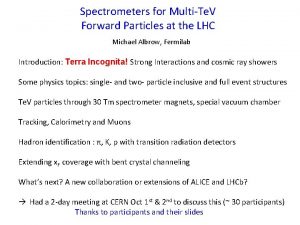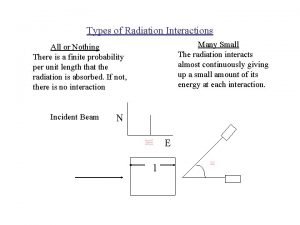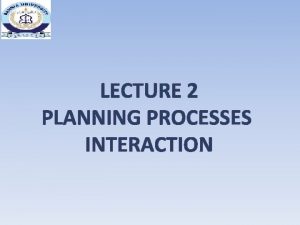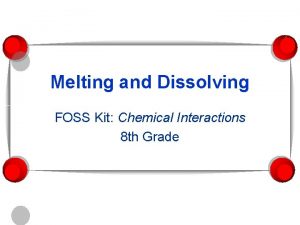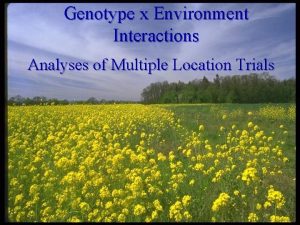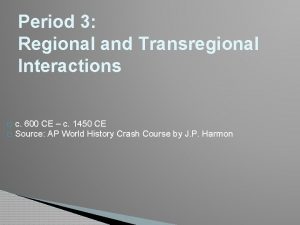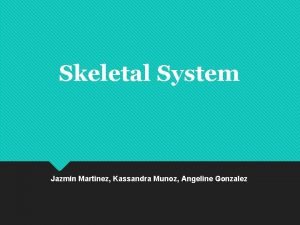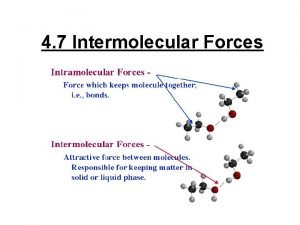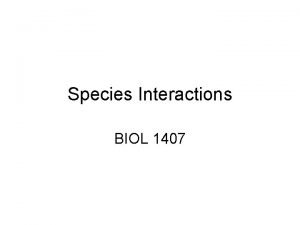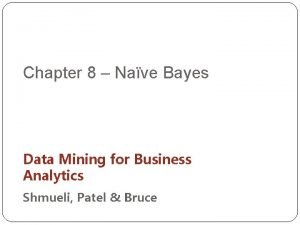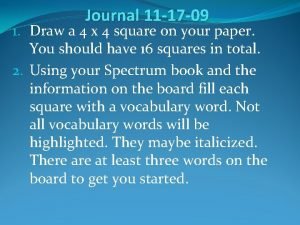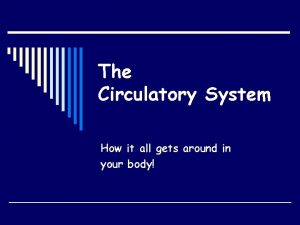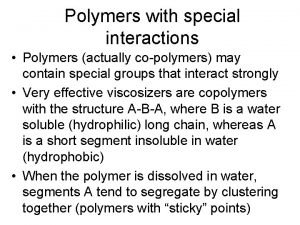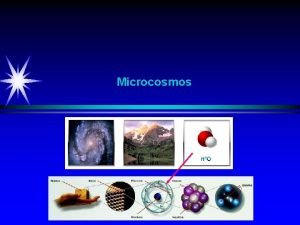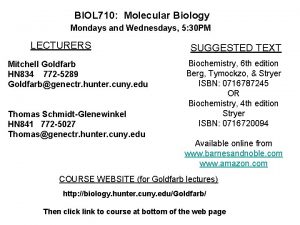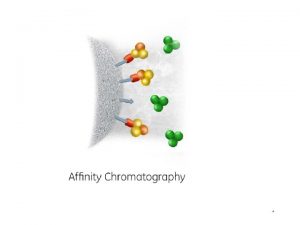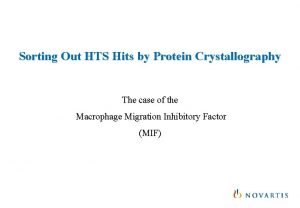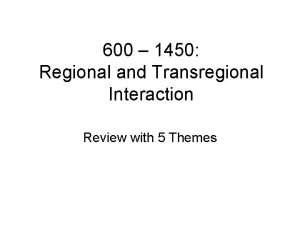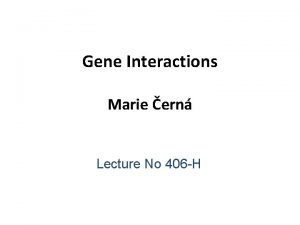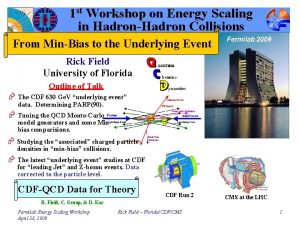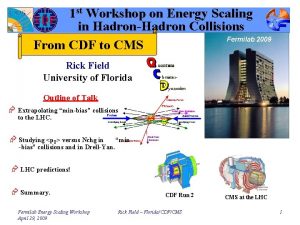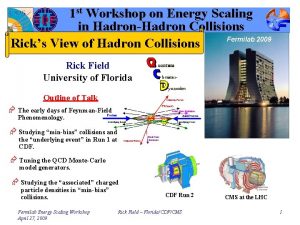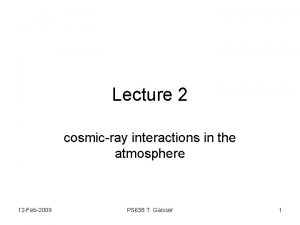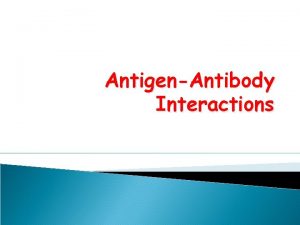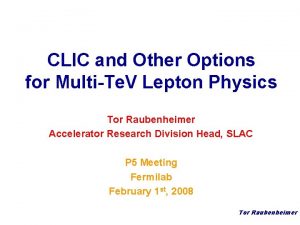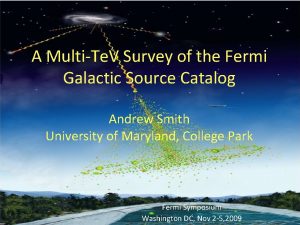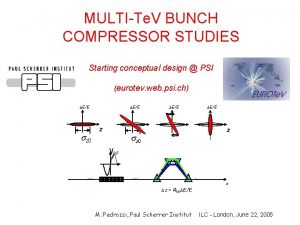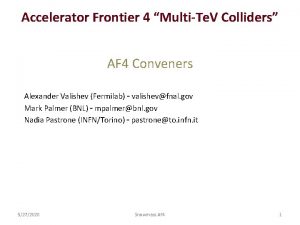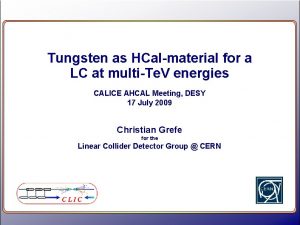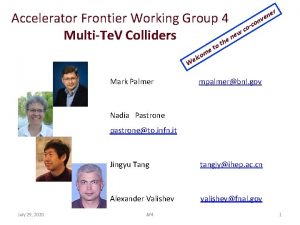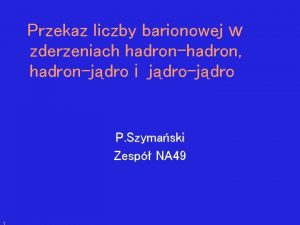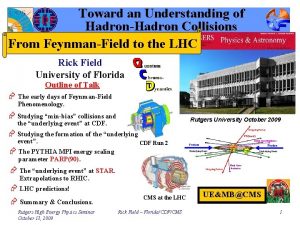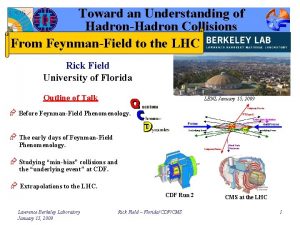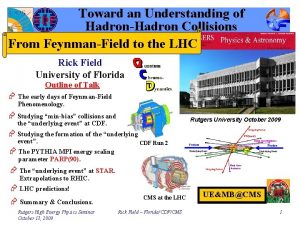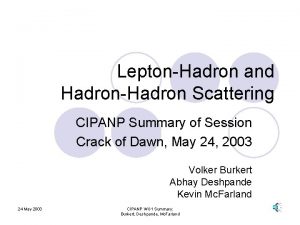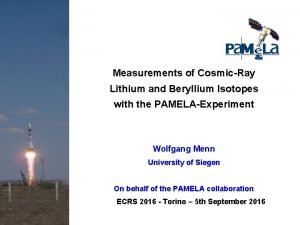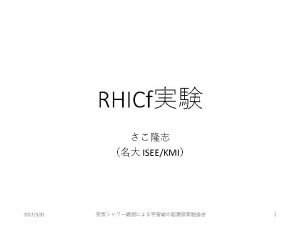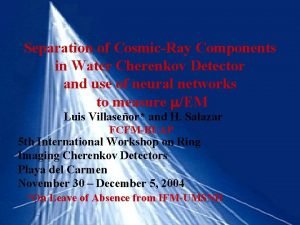Workshop on HadronHadron CosmicRay Interactions at multiTe V
































![Arm 1 position resolution 200 Ge. V electrons σX[mm] Number of event σX=172µm x-pos[mm] Arm 1 position resolution 200 Ge. V electrons σX[mm] Number of event σX=172µm x-pos[mm]](https://slidetodoc.com/presentation_image_h2/b592c0d5a35b325320ceb82dc1da3e4f/image-33.jpg)
![Arm 2 position resolution σX=40µm σX[µm] 200 Ge. V electrons x-pos[mm] σY[µm] σY=64µm E[Ge. Arm 2 position resolution σX=40µm σX[µm] 200 Ge. V electrons x-pos[mm] σY[µm] σY=64µm E[Ge.](https://slidetodoc.com/presentation_image_h2/b592c0d5a35b325320ceb82dc1da3e4f/image-34.jpg)






- Slides: 40

Workshop on Hadron-Hadron & Cosmic-Ray Interactions at multi-Te. V Energies ECT* - Trento, Nov 29 th - Dec 3 rd, 2010 Preliminary results on neutral particles in the forward region at LHC with the LHCf experiment Massimo Bongi - INFN (Florence, Italy) LHCf Collaboration

Hadron-Hadron & Cosmic-Ray Interactions at multi-Te. V Energies • Recent excellent observations (e. g. PAO, Hi. Res, TA) but the origin and composition of UHECR is still unclear • Uncertainty in hadron-hadron interactions affects: – the prediction of Xmax – SD observations • AUGER • Study of very forward particle emission at as high as possible energy is indispensable LHC forward (LHCf) experiment Massimo Bongi – CRLHC Workshop – 29 th November 2010 – ECT* Trento

CR <=> LHC connection § The dominant contribution to the energy flux in the atmospheric shower development comes from the very forward produced particles § Precise measurement of , 0 and n spectra in the very forward region at LHC § 7 Te. V + 7 Te. V in the CM frame ~1017 e. V in “fixed target” frame CR LHC Massimo Bongi – CRLHC Workshop – 29 th November 2010 – ECT* Trento

The LHCf Collaboration K. Fukatsu, Y. Itow, K. Kawade, T. Mase, K. Masuda, Y. Matsubara, G. Mitsuka, K. Noda, T. Sako, K. Suzuki, K. Taki Solar-Terrestrial Environment Laboratory, Nagoya University, Japan K. Yoshida Shibaura Institute of Technology, Japan K. Kasahara, M. Nakai, Y. Shimizu, T. Suzuki, S. Torii T. Tamura Y. Muraki Waseda University, Japan Kanagawa University, Japan Konan University, Japan M. Haguenauer Ecole Polytechnique, France W. C. Turner LBNL, Berkeley, USA O. Adriani, L. Bonechi, M. Bongi, R. D’Alessandro, M. Grandi, H. Menjo, P. Papini, S. Ricciarini, G. Castellini A. Tricomi J. Velasco, A. Faus D. Macina, A-L. Perrot INFN and Universita’ di Firenze, Italy INFN and Universita’ di Catania, Italy IFIC, Centro Mixto CSIC-UVEG, Spain CERN, Switzerland Massimo Bongi – CRLHC Workshop – 29 th November 2010 – ECT* Trento

Experimental set-up CMS/TOTEM ALICE LHCf ATLAS Protons Charged particles (+) Neutral particles Beam pipe Charged particles (-) LHCb LHCf Detector (Arm 1) ATLAS 140 m 96 mm Massimo Bongi – CRLHC Workshop – 29 th November 2010 – ECT* Trento

Particle and energy flow vs pseudorapidity Multiplicity @ 14 Te. V Energy Flux @ 14 Te. V simulated by DPMJET 3 Low multiplicity High energy flux Massimo Bongi – CRLHC Workshop – 29 th November 2010 – ECT* Trento

Arm 1 detector • Sampling E. M. calorimeters: each detector has two Scintillating Fibers + MAPMT: 4 pairs of layers (at 6, 10, 30, 42 X 0), tracking measurements (resolution < 200 μm) calorimeter towers, which allow to reconstruct 0 40 mm • Front counters: thin plastic scintillators, 80 x 80 mm 2 § monitor beam condition § rejection of background due to beam - 20 mm residual gas collisions by coincidence analysis Absorber : 22 tungsten Plastic Scintillator : 16 layers, layers 3 mm thick, layers, 44 X 0, 1. 7 trigger and energy profile measurement Massimo Bongi – CRLHC Workshop – 29 th November 2010 – ECT* Trento

Arm 2 detector • Sampling E. M. calorimeters: each detector has two Silicon Microstrip : 4 pairs of layers (at 6, 12, 30, 42 X 0), tracking measurements (resolution ~ 40 μm) calorimeter towers, which allow to reconstruct 0 32 mm • Front counters: thin plastic scintillators, 80 x 80 mm 2 § monitor beam condition 25 mm § rejection of background due to beam residual gas collisions by coincidence analysis Absorber : 22 tungsten Plastic Scintillator : 16 layers, layers 3 mm thick, layers, 44 X 0, 1. 7 trigger and energy profile measurement Massimo Bongi – CRLHC Workshop – 29 th November 2010 – ECT* Trento

ATLAS & LHCf Massimo Bongi – CRLHC Workshop – 29 th November 2010 – ECT* Trento

290 mm Arm 1 detector 90 mm Arm 2 detector Massimo Bongi – CRLHC Workshop – 29 th November 2010 – ECT* Trento

Expected results @ 14 Te. V collisions Energy spectra and transverse momentum distribution of: • photons (E > 100 Ge. V): 5% • neutral pions (E > 500 Ge. V): 3% • neutrons (E > few 100 Ge. V): 30% E/E < E/E ~ in the pseudo-rapidity range > 8. 4 n 0 Massimo Bongi – CRLHC Workshop – 29 th November 2010 – ECT* Trento

Summary of operations in 2009 and 2010 With Stable Beam at 900 Ge. V Total of 42 hours for physics ~ 105 showers events in Arm 1+Arm 2 With Stable Beam at 7 Te. V Total of 150 hours for physics with different setups Different vertical position to increase the accessible kinematical range Runs with or without beam crossing angle ~ 4· 108 shower events in Arm 1+Arm 2 ~ 106 0 events in Arm 1+Arm 2 Status Completed program for 900 Ge. V and 7 Te. V Removed detectors from tunnel in July 2010 Post-calibration beam test in October 2010 Upgrade to more rad-hard detectors to operate at 14 Te. V in 2013 Massimo Bongi – CRLHC Workshop – 29 th November 2010 – ECT* Trento

Te. V rays not from Crab but… …underground! Longitudinal projections A 2 32 mm A 2 25 mm X Transverse projection A 2 32 mm A 2 25 mm Y Transverse projection Massimo Bongi – CRLHC Workshop – 29 th November 2010 – ECT* Trento

Particle identification Typical transition curve for rays Typical transition curve for hadrons Thick for E. M. interaction (44 X 0) Thin for hadronic interaction(1. 7 ) § MC (QGSJET 2) • data hadron like Definition of L 90% • L 90% is the longitudinal position containing 90% of the shower energy Selection of rays: • PID study is still ongoing (use of neural networks Massimo Bongi – CRLHC Workshop – 29 th November 2010 – ECT* Trento L 90% < 16 X is under investigation) 0 + 0. 002 xΣE r ry of Arm 1 -ray like mi na 40 mm cal. pr eli L 90% @

Energy spectra at 900 Ge. V gamma-ray like hadron like Arm 1 PR PR EL EL IM IM IN IN AR Y Acceptance is different for the two arms. Spectra are normalized by # of -ray and hadron like events. Massimo Bongi – CRLHC Workshop – 29 th November 2010 – ECT* Trento Response for hadrons and systematic errors are under study. Arm 2 Only statistical errors are shown

Energy spectra at 7 Te. V gamma-ray like hadron like RY INA LIM PR E LIM INA RY Arm 1 Very high statistics: only 2% of data is shown here. Massimo Bongi Workshop – 29 th November 2010 – ECT* Trento Comparison with MC is– CRLHC under development Arm 2 Only statistical errors are shown

Neutral pions An example of event (Arm 2) 25 mm 32 mm Silicon strip - X view 1(E 1) R • 0 s pre lim ina ry Reconstructed mass (Arm 2) 140 m 2(E 2) Energy spectrum (Arm 2) M/M = 2. 3% I. P. 1 are a main source of electromagnetic secondaries in high energy collisions • the mass peak is very useful to confirm the detector performances and to estimate the systematic error of energy scale calibration pre Massimo Bongi – CRLHC Workshop – 29 th November 2010 – ECT* Trento lim ina ry

2 invariant mass spectrum @ 7 Te. V 0 candidates pr eli mi na ry • The search for particles is an important tool for discriminating hadronic interaction models, because their spectra differ from model to model • Important tool also for energy scale calibration Massimo Bongi – CRLHC Workshop – 29 th November 2010 – ECT* Trento

14 Te. V in 2013: not only the highest energy, but energy dependence too! SIBYLL 7 Te. V 10 Te. V 14 Te. V QGSJET 2 de tec t tak or ap e e ac n in rtur co t e un o t 7 Te. V 10 Te. V 14 Te. V §Secondary gamma-ray spectra in p-p collisions at different collision energies (normalized to the maximum energy) §SIBYLL predicts perfect scaling while QGSJET 2 predicts softening at higher energy Massimo Bongi – CRLHC Workshop – 29 th November 2010 – ECT* Trento

Schedule and future plan 2010, Oct Beam test at SPS to confirm the radiation damage and the performance end of 2010 Finalize analysis at 900 Ge. V (almost completed) and at 7 Te. V 2011 - 2012 Upgrade the detector for radiation hardness: replacement of scintillators and Sci. Fi with GSO 2013 Re-installation of detectors in the tunnel for operation at 14 Te. V Then we are thinking about: - Operation at LHC light ion collisions (not Pb-Pb). Massimo Bongi – CRLHC Workshop – 29 th November 2010 – ECT* Trento

Conclusions § LHCf is a forward experiment at LHC; its aim is to measure energy spectra and transverse momentum distributions of very energetic neutral secondaries from p-p interactions in the very forward region of IP 1 (at > 8. 4) § Results will help calibrating the hadronic interaction models; one important field where this measurements are mostly important is the study of atmospheric showers induced by HECR § LHCf successfully completed operations at 900 Ge. V and at 7 Te. V; the detectors have been removed from the LHC tunnel on 21 st July 2010 § Analysis of data at 900 Ge. V is almost completed; we will finalize analysis at 7 Te. V before the end of this year § Detectors will be upgraded in 2011 -2012 for radiation hardness and will be re-installed for data taking at 7 Te. V + 7 Te. V in 2013 Massimo Bongi – CRLHC Workshop – 29 th November 2010 – ECT* Trento

Backup

Open Issues on UHECR spectrum AGASA Systematics Total ± 18% Hadr Model ~10% (Takeda et al. , 2003) M Nagano New Journal of Physics 11 (2009) 065012 Depth of the max of the shower Xmax in the atmosphere AUGER Hi. Res Massimo Bongi – CRLHC Workshop – 29 th November 2010 – ECT* Trento

IP 1, ATLAS Arm 2 η Arm 1 Shadow of beam pipes between IP and TAN 8. 4 8. 7 ∞ is x a m a be l a r t u ne ∞ @ 140 mrad crossing angle Transverse projection of Arm#1 @ zero crossing angle

Detector vertical position and acceptance Remotely changed by a manipulator( with accuracy of 50 mm) Data taking mode Viewed from IP G Distance from neutral center with different position to cover PT gap Beam pipe aperture N L Neutral flux center All from IP 7 Te. V collisions L Collisions with a crossing angle lower the neutral flux center thus enlarging Pt acceptance N

LHCf single geometrical acceptance Mechanical manipulators allows to remotely move LHCf: some runs with the detectors vertically shifted few cm allow to cover the whole kinematical range Massimo Bongi – CRLHC Workshop – 29 th November 2010 – ECT* Trento

LHCf acceptance on PT -E plane 140 le b a ct Beam crossing angle s ev t n e e t e D A vertical beam crossing angle > 0 Massimo Bongi – the CRLHC Workshop – 29 th November – ECT* Trento increases acceptance of 2010 LHCf

Front counters • Thin scintillators with 8 x 8 cm 2 acceptance, which have been installed in front of each main detector. Schematic view of Front counter • To monitor beam condition. • For background rejection of beam-residual gas collisions by coincidence analysis Massimo Bongi – CRLHC Workshop – 29 th November 2010 – ECT* Trento

Beam-gas backgroud @ 900 Ge. V 2009 2010 Very big reduction in the Beam Gas contribution!!! Beam gas I, while interactions I 2 Massimo Bongi – CRLHC Workshop – 29 th November 2010 – ECT* Trento

Comparison of Arm 1 and Arm 2 @ 7 Te. V preliminary Red : Arm 1 Blue : Arm 2 Same runs, same conditions, common rapidity region selected. Spectra corrected for the live time of detectors. Massimo Bongi – CRLHC Workshop – 29 th November 2010 – ECT* Trento

Selection of rapidity region (comparison Arm 1/2) R 1=5 mm R 2 -1 = 35 mm R 2 -2 = 42 mm theta = 20˚ Both Arm 1 and Arm 2 cover the same rapidity area in small and large tower. Here the beam center is determined by our measurements. Massimo Bongi – CRLHC Workshop – 29 th November 2010 – ECT* Trento

LHCf energy resolution 2 tower 2. 5 x 2. 5 cm 2 tower 2. 0 x 2. 0 cm Energy resolution < 5% at high energy, even for the smallest tower Massimo Bongi – CRLHC Workshop – 29 th November 2010 – ECT* Trento
![Arm 1 position resolution 200 Ge V electrons σXmm Number of event σX172µm xposmm Arm 1 position resolution 200 Ge. V electrons σX[mm] Number of event σX=172µm x-pos[mm]](https://slidetodoc.com/presentation_image_h2/b592c0d5a35b325320ceb82dc1da3e4f/image-33.jpg)
Arm 1 position resolution 200 Ge. V electrons σX[mm] Number of event σX=172µm x-pos[mm] E[Ge. V] Number of event σY[mm] σY=159µm y-pos[mm] E[Ge. V] Massimo Bongi – CRLHC Workshop – 29 th November 2010 – ECT* Trento
![Arm 2 position resolution σX40µm σXµm 200 Ge V electrons xposmm σYµm σY64µm EGe Arm 2 position resolution σX=40µm σX[µm] 200 Ge. V electrons x-pos[mm] σY[µm] σY=64µm E[Ge.](https://slidetodoc.com/presentation_image_h2/b592c0d5a35b325320ceb82dc1da3e4f/image-34.jpg)
Arm 2 position resolution σX=40µm σX[µm] 200 Ge. V electrons x-pos[mm] σY[µm] σY=64µm E[Ge. V] y-pos[mm] Alignment has been taken into account E[Ge. V] Massimo Bongi – CRLHC Workshop – 29 th November 2010 – ECT* Trento

Leakage Correction correction 2 mm (Arm 1 prototype) Massimo Bongi – CRLHC Workshop – 29 th November 2010 – ECT* Trento

Radiation damage studies § Dose evaluation on the basis § test of Scintillating fibers and scintillators of LHC reports on radiation environment at IP 1 § ~ 100 Gy/day @ 1030 cm-2 s-1 luminosity are expected § ~ 10 k. Gy during few months operation lead to ~ 50% light output decrease § continuous laser calibration to monitor scintillators and 30 k. Gy correct for the decrease of light output Massimo Bongi – CRLHC Workshop – 29 th November 2010 – ECT* Trento

Accumulated Events in 2010 108 events! LHCf removal Massimo Bongi – CRLHC Workshop – 29 th November 2010 – ECT* Trento

LHCf Arm 1 – installation Massimo Bongi – CRLHC Workshop – 29 th November 2010 – ECT* Trento

LHCf Arm 2 – installation Massimo Bongi – CRLHC Workshop – 29 th November 2010 – ECT* Trento

LHCf data taking The LHCf control room in the ATLAS area
 Covie
Covie Photosynthesis is important to animals because flocabulary
Photosynthesis is important to animals because flocabulary Types of interactions
Types of interactions Project management process interactions
Project management process interactions Wave interactions
Wave interactions Lesson 2 activity 45 macroeconomics
Lesson 2 activity 45 macroeconomics Foss chemical interactions
Foss chemical interactions Integral vs modular architecture
Integral vs modular architecture Chapter 22 reaching out cross-cultural interactions
Chapter 22 reaching out cross-cultural interactions Diazepam cyp450
Diazepam cyp450 Interactions
Interactions Regional and transregional interactions
Regional and transregional interactions Kassandra munoz
Kassandra munoz Branch of biology dealing with interactions among organisms
Branch of biology dealing with interactions among organisms Chapter 5 evolution and community ecology answer key
Chapter 5 evolution and community ecology answer key Intermolecular force
Intermolecular force Parasitism
Parasitism Ecosystems interactions
Ecosystems interactions Different types of community interactions
Different types of community interactions Naive bayes pays attention to complex interactions and
Naive bayes pays attention to complex interactions and Wave interactions
Wave interactions Circulatory system interactions with other systems
Circulatory system interactions with other systems Insight therapies involve verbal interactions
Insight therapies involve verbal interactions The properties and interactions of magnets
The properties and interactions of magnets Noncovalent interactions
Noncovalent interactions Niches and community interactions
Niches and community interactions Special interactions
Special interactions Chapter 22 reaching out cross-cultural interactions
Chapter 22 reaching out cross-cultural interactions Neutrinous
Neutrinous What factors influence communication
What factors influence communication Geosphere examples
Geosphere examples Niches biology
Niches biology Dna-protein interactions
Dna-protein interactions Narrative report with contextual description
Narrative report with contextual description Molecular biology
Molecular biology Protein binding interactions
Protein binding interactions Hccee
Hccee Regional and transregional interactions
Regional and transregional interactions Chapter 22 reaching out cross-cultural interactions
Chapter 22 reaching out cross-cultural interactions Interactions among living things
Interactions among living things Epistasis types
Epistasis types
